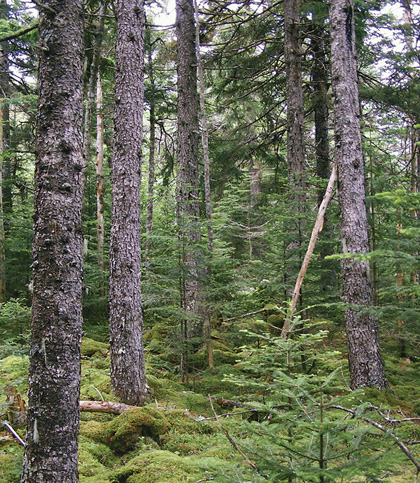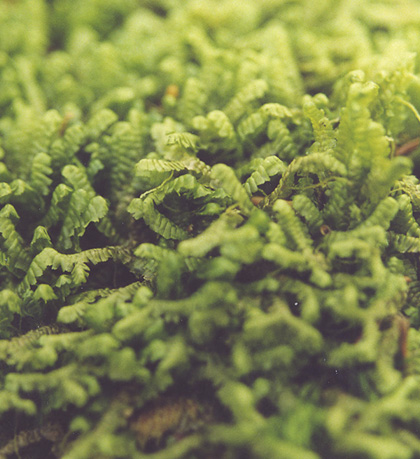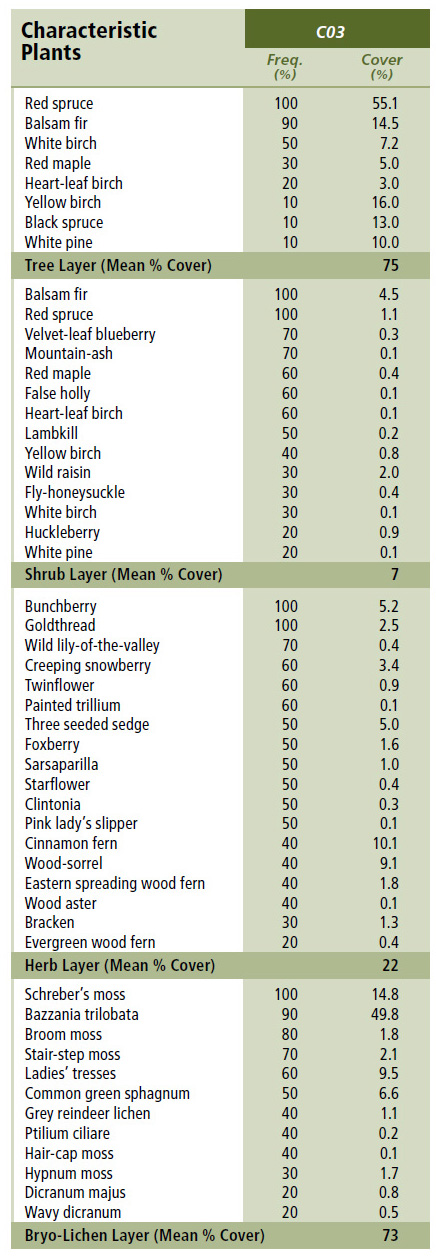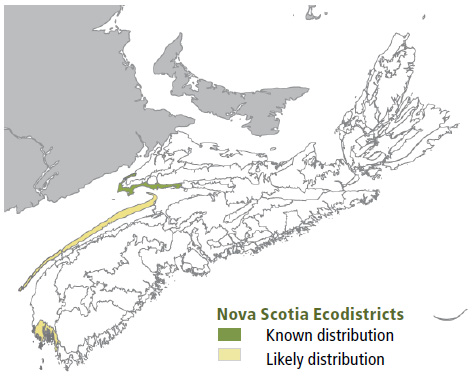
Forest Vegetation types - CO3
CO3 — Red spruce / Mountain-ash / Foxberry
Picea rubens / Sorbus americana / Vaccinium vitis-idaea
 |
Keyhole Brook, Cape Chignecto, Cumberland County |
Concept: This late successional Vegetation Type (VT) has an overstory dominated by red spruce with a component of balsam fir. CO3 is the only Maritime Boreal VT dominated by red spruce. Besides the presence of typical coastal forest species (e.g. mountain-ash and foxberry), CO3 differs from Acadian red spruce vegetation types by its relatively thick duff layer and extensive bazzania cover. The absence of hemlock, which is typically a component of Nova Scotia red spruce forests, is also a distinguishing feature of CO3. Red spruce / Mountain-ash / Foxberry is mainly found along the Bay of Fundy slopes.
Vegetation: Red spruce is the dominant overstory tree, with balsam fir and white birch as common associates. Yellow birch, black spruce, red maple and heart-leaf birch are also found in some stands. The poorly-developed shrub layer is dominated by regenerating trees along with mountain-ash and velvet-leaf blueberry. The herb layer shows more development and includes typical upland flora such as twinflower, bunchberry, goldthread and sarsaparilla. Scattered foxberry can also be found, with cinnamon fern and three seeded sedge on wetter sites. Bazzania dominates the bryophyte layer.
Environmental Setting: CO3 is mainly associated with fresh to moist, nutrient medium soils of glacial origin. These soils are generally medium to coarse textured. CO3 and earlier successional stages cover most of the well to imperfectly drained slopes along the Bay of Fundy. The best examples are found along Cape Chignecto where steep slopes limited the conversion of forest to agricultural land (as happened on the more gentle North Mountain slopes). This VT can also be found in the Tusket Islands ecodistrict. High winds and exposure limit tree height potential in CO3 stands. The VT occurs on the Fundy coast of New Brunswick.
Successional Dynamics: CO3 is a late successional VT dominated by red spruce. This VT typically follows stand-replacing disturbances such as windthrow, insect infestation and harvesting. The longevity and shade tolerance of red spruce provides an opportunity for the development of uneven-aged forests maintained by gap disturbances. CO4 (Balsam fir / Foxberry - Twinflower) can be a mid-successional stage. Forests that originate after harvesting may initially be dominated by pin cherry, raspberry, white birch, heart-leaf birch and mountain-ash.
Ecological Features: This closed canopy, large patch forest is primarily associated with the Fundy Shore ecoregion. The best provincial examples are along the slopes of Cape Chignecto, where steep topography limited forest conversion to agriculture. Along the more gentle Fundy slopes of the North Mountain, few stands have been spared from past and present farming. These forests feature some of the world's oldest red spruce, including the world record 445-year-old found at Fundy National Park. Mature forests develop abundant old man's beard, a lichen used as nest material by warblers and other species, and a winter food for deer foraging on fallen trees. The rare arctic kidney lichen is found in some stands.
 |
| Bazzania |
Distinguishing Features: Red spruce is diagnostic for this softwood forest found only along the Bay of Fundy and among the Tusket Islands. The presence of mountain-ash, heart-leaf birch, foxberry and bazzania are indicators of a coastal influence, although they are not always present.
| Slope Position: | Upper4 Middle3 Lower2 Level1 |
Surface Stoniness: |
(Non - Slightly)10 |
Bedrock Outcrop: |
(Non-rocky)10 |
Elevation Range: |
27 - 66m |
Slope Gradient: |
Gentle8 Level1 nd1 |
Aspect: |
North2 East2 West5 None1 |
Exposure: |
Exposed6 Mod. Exposed3 Moderate1 |
Microtopography: |
Moderately4 Slightly4 Level1 Strongly1 |
Drainage: |
Imperfect5 Well3 Moderately well1 Poor1 |
Soil Type: |
ST34ST23 ST2-L1 ST3-L1 ST41 |
Parent Material: |
Glacial till10 |
Rooting Depth (cm): |
(<30)2 (30-45)8 |
Duff Thickness (cm): |
(11-20)9 (21-40)1 |

